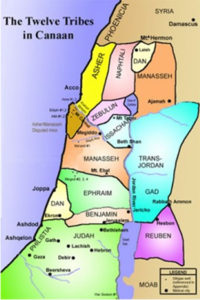A Simple Way to Check Integrity of the Gospels
Integrity of the Gospels can be the first step in accepting its believability. Checking integrity and its witness accounts can be as simple as comparing one Gospel account to another, a process known as “literary analysis.”[1]
Chances are very high that in its simplest form, literary analysis is part of a everyday personal activity. It happens naturally when mentally breaking down information to understand it better such as the text of a book, magazine article, blog, marketing ads, instructions, maps, etc.[2]
Comparing two or more Gospels is a simple method considering such things as word usage, meaning, consistency, historical accuracy, theme, etc.[3]
Four authors of Gospels books Matthew, Mark, Luke and John are a target-rich environment for literary analysis to compare and evaluate times, places and circumstances. Texts of antiquity from that era can even be referenced such as works by Jewish historian Josephus, Caesar Augustus, and Roman historians Suetonius and Tacitus.

Fact-checking today using the Internet with topical searches can result in finding reliable, unbiased secondary sources such as encyclopedias, bios, historical websites, university library websites, etc. Be cautious, many sites are biased, not factual, and may include unscrupulous tactics.
See if a Gospel stands up to scrutiny.[4] Obviously, the more knowledgeable about the subject matter, the better the analysis.
Knowing the difference between “evidence” and “facts” and understanding the cultural the rules for the era in which the literary work was written is very helpful. Big differences may have occurred between today and those of yesteryear where some literary protocols that may have been legitimate for that era are not acceptable practices today.
An example, citing or referencing a literary work had different rules in the age of antiquity when it was permissible to copy from another source to serve as a “witness” meaning it was common practice to copy from another source, even verbatim, without a citation. Abuses of this practice was the focus of Josephus in his work, Against Apion.[5]
A common factor that comes into play known as “parallel” passages, a legitimate Jewish writing style. Parallel passages are cited as alleged credibility issues of the synoptic Gospels.
Sometimes verbatim, the verses appear in Matthew, Mark and Luke leading these three to be called the Synoptic Gospels. Completely independent, the eyewitness Gospel of John often corroborates the Synoptic Gospels making it tough to disregard the information.
Understanding the theme helps determines the central idea of the writing. A big clue is the purpose of the author.[6]
Is an individual Gospel a fiction or non-fiction? Consider if the content is about real people, places and events (non-fiction) vs. content that is an invented story (fiction) written often for philosophical or entertainment purposes.
Fictions involve characters who are not real although they could believably be real people with resemblances to real persons. As a setting, the work may include real places, periods and events, but the story is always imaginary, artificial, not real.
Non-fictions, on the other hand, are written with the intention to be informative about real people, places or events based on historical, geographical or biographical facts. Non-fictions may also reflect the author’s recollection of witnessing events or facts often influenced by personal experiences.
Ask yourself, is the central theme of a Gospel about a real person by chronicling the birth, life, trial and execution of Jesus of Nazareth in the Judean Roman province – historical? Is the theme intended to teach his message of love and forgiveness – philosophical? Or perhaps, is the theme intended to convey a belief in Jesus as the promised Messiah exemplified by fulfillment of prophecies and Resurrection – religion?
A very close cousin to literary analysis is known as “textual criticism,” another term that seems intimidating and boring…and probably is for most people. For this reason, textual analysis may best be reserved for literary experts who are so inclined.
To save time and effort, consult the learning and work of others. For example, Brooke Foss Westcott and Fenton John Anthony Hort, better known as just “Westcott & Hort,” spent a lifetime performing in-depth analysis of manuscripts of the Bible.[7]
In the end, the conclusion can be one reached on a personal level, perhaps influenced by opinions and biases, weighed against observations, evaluation and factual accuracy. Is there integrity within the Gospels?
Updated March 9 2025.

This work is licensed under a Creative Commons Attribution-NonCommercial-NoDerivatives 4.0 International License.
REFERENCES:
[1] Jenkins, Rob. “Literary Analysis as Scientific Method.” The Chronicles of Higher Education. 2012. <http://www.chronicle.com/blogs/onhiring/literary-analysis-as-scientific-method/30565> Godin, Katherine. “How to Analyze a Literary Passage: A Step-by-Step Guide.” Study.com. 2019. <http://study.com/academy/lesson/how-to-analyze-a-literary-passage-a-step-by-step-guide.html> Reed, Annette Yoshiko. Pseudepigraphy, Authorship, and ‘The Bible’ in Late Antiquity. 2008. p 478. p 476-479. “Hebrew Bible: Torah, Prophets and Writings.” MyJewishLearning.com. <https://www.myjewishlearning.com/article/hebrew-bible> Benner, Jeff, Ancient Hebrew Research Center. 2018. “The Authors of the Torah.” <http://www.ancient-hebrew.org/articles_authors.html> Infomory.com. August 21, 2011 <http://infomory.com/what-is/what-is-literary-analysis> “Introduction to Literary Criticism and Analysis.” National Endowment for the Humanities | EDSITEment. “Introduction to Literary Criticism and Analysis.” National Endowment for the Humanities | EDSITEment. <http://edsitement.neh.gov/sites/edsitement.neh.gov/files/worksheets/Critical%20Ways%20of%20Seeing%20The%20Adventures%20of%20Huckleberry%20Finn%20in%20Context%20-%20Introduction%20to%20Literary%20Criticism%20and%20Analysis.pdf>
[2] Godin. “How to Analyze a Literary Passage: A Step-by-Step Guide.”
[3] Cherran. “What is Literary Analysis?” Ramlawi, Aisha. “Literary Analysis: Genre/Tone/Mood/Theme.” Prezi.com. 2016 <https://prezi.com/ararehyeyma0/literary-analysis-genretonemoodtheme>
[4] Reade. “Selecting topics for literary analysis.” Jenkins. “Literary Analysis as Scientific Method.” “Introduction to Literary Criticism and Analysis.” National Endowment for the Humanities | EDSITEment.
[5] Josephus, Flavius. Against Apion. Trans. and commentary William Whitson. The Complete Works of Josephus. 1850. n.d. <http://books.google.com/books?id=e0dAAAAAMAAJ&printsec=frontcover&source=gbs_ge_summary_r&cad=0#v=onepage&q&f=false> “Preface.” Reed. Pseudepigraphy, Authorship, and ‘The Bible’ in Late Antiquity. Custom Cheating and Plagiarism essay paper writing service.” ExclusivePapers.com. n.d. <http://exclusivepapers.com/essays/Informative/cheating-and-plagiarism.php> Cummings, Michael J. “Did Shakespeare Plagiarize?” Cummings Study Guides. 2003. <http://cummingsstudyguides.net/xPlagiarism.html>
[6] Ramlawi. “Literary Analysis: Genre/Tone/Mood/Theme.” Prabhat S. “Difference Between Fiction and Non fiction.” 2011. DifferenceBetween.net. <http://www.differencebetween.net/miscellaneous/difference-between-fiction-and-non-fiction> Cherran. “What is Literary Analysis?” Reade, Dan. “Selecting topics for literary analysis.” Sophia.org. 2017. <https://www.sophia.org/tutorials/selecting-topics-for-literary-analysis> Ramlawi,. “Literary Analysis: Genre/Tone/Mood/Theme.”
[7] Westcott & Hort Greek / English Interlinear NEW TESTAMENT. Ed. Ray McIntyre. Westcott & Hort Research Center. n.d. <http://westcotthort.com/books/Westcott_Hort_Interlinear.pdf Westcott & Hort Biographies.” Westcott and Hort Research Centre. 1911 edition of the Encyclopedia Britannica. <http://www.westcotthort.com/biographies.html>
 Israel conquered its enemies in the land and each of the 12 tribes of the sons of Israel were allotted their own regions.
Israel conquered its enemies in the land and each of the 12 tribes of the sons of Israel were allotted their own regions.